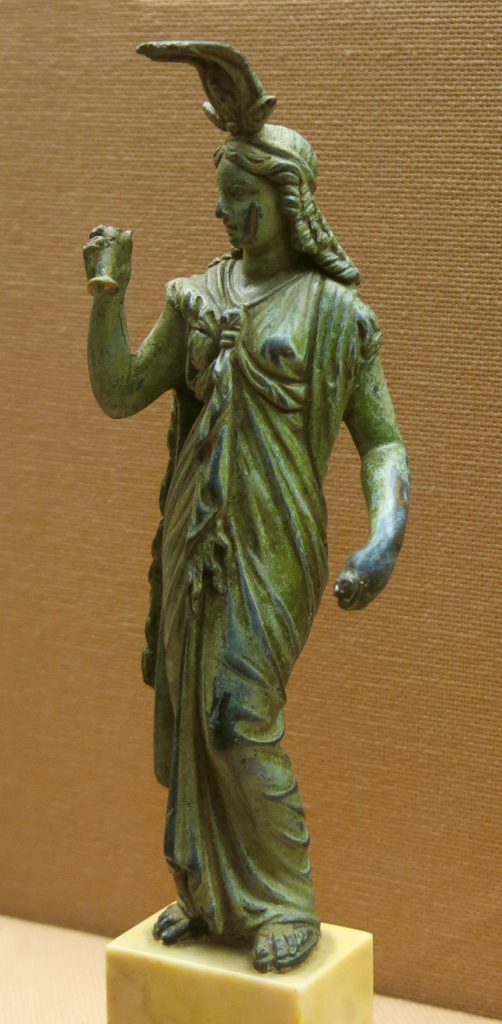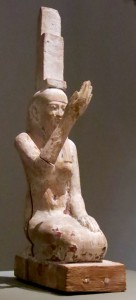Isis is a well-known Egyptian goddess who needs little introduction. This beautiful little sculpture of Isis dates from a period when the Romans ruled Egypt; so Isis is wearing an Egyptian headdress, but she’s also wearing Roman clothing.

Above: Isis with sistrum, from Roman Imperial period, c. 100 BCE to 200 CE; bronze. Boston Museum of Fine Arts, accession no. 04.1713.
She is shaking a sistrum, an small percussion instrument that was used almost exclusively by women. Kara Cooney, a professor of Egyptian art and architecture, interprets the sistrum in terms of sexuality: “The sistrum was a kind of rattle — a wooden handle supporting bars of metal, each piercing small rings that clanged together when the instrument was vibrated. The sistrum itself represented human sexuality — round objects penetrated by a phallic rod holding them in place” (1). This interpretation could be accurate, but it could be overly influenced by Freud and Co., and therefore anachronistic.
The archaeologist Joyce Tyldesley offers another interpretation; she says the sistrum, which “was played only by women,” was “a rather large loop-shaped rattle with a long handle, often featuring the head of Hathor [another Egyptian goddess], which had initially represented the papyrus reeds of the Nile Delta where, mythology decreed, Hathor had been forced to hide with her young son. Eventually the sistrum lost all trace of its original meaning and instead started to serve as a religious symbol for life itself. It consequently become absorbed by other deities, and was particularly identified with the cult of Isis at the end of the Dynastic period.” (2) And this sculpture in fact does date from the end of the Dynastic period, the time when Isis had taken over the sistrum form Hathor.
Thus in this sculpture, we see the goddess Isis at the end of some three millennia of change and development. She is wearing the flowing robes of Rome rather than the simple sheath dress of Dynastic Egypt. She wears a headdress that identifies her as Isis, though it is not the older stepped headdress of Isis seen in sculptures from 500 years earlier (see, e.g., the sculpture of Isis below, from c. 685-525 BCE). And she has taken over the sistrum from Hathor and other goddesses.
Although their adherents may say otherwise, art and material culture does not show gods and goddesses as unchanging and fixed; instead, they grow and evolve over time.

Above: Isis mourning Osiris, from Dynasty 26, c. 685-525 BCE; wood. Boston Museum of Fine Arts, accession no. 72.4172.
Notes:
(1) Kara Cooney, The Woman Who Would Be King (New York: Broadway Books, 2014), p. 39.
(2) Joyce Tyldesley, Daughters of Isis: Women of Ancient Egypt (London: Penguin, 1994), p. 139.
